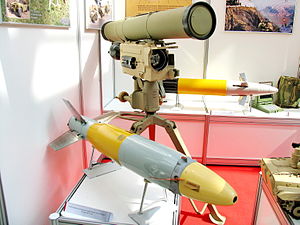AT-14 Kornet
| 9M133 Kornet | |
|---|---|

9M133 missile with launcher
|
|
| Type | Anti-tank missile |
| Place of origin | Russia |
| Service history | |
| In service | 1998–present |
| Used by | See Operators |
| Wars | See Combat history |
| Production history | |
| Designer | KBP Instrument Design Bureau |
| Designed | 1988-1998 |
| Manufacturer | Degtyarev plant |
| Produced | 1994–present |
| Number built | 35,000 (2009) |
| Variants | See Variants |
| Specifications (9M133) | |
| Weight | 27 kg (29 kg with launch tube) |
| Length | 1200 mm |
| Diameter | 152 mm |
| Warhead | 1000-1200 (9K135), 1200 (E), 1300 (D) mm RHA penetration after ERA with Tandem HEAT, Thermobaric |
| Warhead weight | 4.6 kg (10 lb) HEAT |
|
Detonation
mechanism |
Impact fuze |
|
|
|
| Wingspan | 460 mm |
| Propellant | Solid-fuel rocket |
|
Operational
range |
|
|
Guidance
system |
SACLOS laser beam riding |
|
Steering
system |
Two control surfaces |
| Accuracy | <5 m |
|
Launch
platform |
Individual, vehicles, Kornet-T, Kornet-D, Bumerang-BM |
The Kornet (Russian: "Корнет"; English: Cornet) is a Russian anti-tank guided missile (ATGM). It is intended for use against main battle tanks, but is not intended to fully replace previous systems, due to its high cost. The missile carries the GRAU designation 9M133 and the NATO reporting name AT-14 Spriggan. It was first introduced into service with the Russian Army in 1998. Its export designation is the Kornet-E.
The Kornet anti-tank missile was unveiled in October 1994 by the KBP Instrument Design Bureau. The missile started development in 1988 as a modular, universal system able to engage any target from a mix of platforms using a reliable laser beam guidance system that was simple to use. It is a heavy ATGM, superior to the earlier 9K111 Fagot (NATO: AT-4 Spigot) and 9K113 Konkurs (NATO: AT-5 Spandrel) wire-guided ATGMs, but not to replace them (due to the cost). The missile entered service in the Russian army in 1998. Its export designation is the Kornet-E.
The Kornet Anti Tank Missile system is an advanced ATGM with spiral trajectory.
The 9M133 missile together with its 9P163-1 tripod launcher and 1PN79-1 thermal sight forms the 9K135 missile system, which can be carried and operated by a two-person infantry crew. The transfer to the firing position takes less than one minute, and preparation and production of a shot in at least one second. In addition to an infantry portable version, the 9K133 system has been integrated into a variety of other vehicles and weapons systems as either an upgrade package or a new weapon system. The 9K133 has been fitted into a BMP-3 to form the 9P163M-1 tank destroyer and is similar in function to the Khrizantema missile system. The 9P163M-1 carries two 9M133 missiles on launch rails, which are extended from a stowed position during transit. Missile are re-loaded automatically by the tank destroyer from an internal magazine with 16 rounds (missiles are stored and transported in sealed canisters).NBC protection is provided for the two crew (gunner and driver) of each 9P163M-1 in addition to full armour protection equivalent to the standard BMP-3 chassis. The guidance system of the 9P163M-1 allows two missiles to be fired at once, each operating on different guidance (laser) channels.
...
Wikipedia
